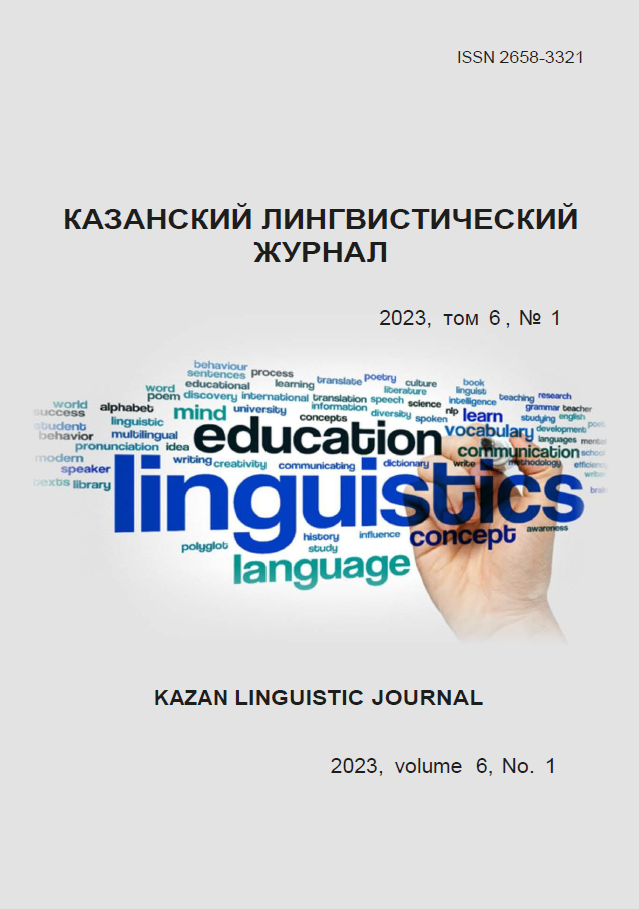Experimental study on the colour red interpretations in British and American linguocultures (based on a survey of artificial bilinguals)
https://doi.org/10.26907/2658-3321.2023.6.1.111-122
Keywords:
colour red, linguoculture, English, rock discourse, album cover, interpretation, experimentAbstract
The article presents the results of an experimental study on the interpretations of the colour red in British and American linguocultures, which was carried out on the material of the rock discourse of these linguocultures and consisted of three stages: preparatory; experimental; final. The goal was to establish whether the psychophysical, linguocultural and lexicographic data about this color in the British and American linguocultures, identified at the preparatory stage, correspond to the actual perception and interpretation of the red color by speakers of English as a second language. According to the results of the first block of the experimental stage (open question), the respondents' answers were divided into two groups – associative definitions and metaphorical associations. Most of them correspond to the data of the preparatory stage. In the second part of this stage, all of the three interpretations of red (“energy”, “revolution / radicalism”, “danger”), identified at the preparatory stage, were successfully established by the respondents when analyzing the proposed covers of British and American rock discourse. For each of the six studied rock covers, it was possible to establish additional interpretations of red. In the third part of the experimental stage (closed question), all interpretations of the color red, determined at the preparatory stage with the help of psychophysical, linguocultural and lexicographic data, were somehow chosen by the respondents, which confirmed their relevance in relation to the studied linguocultures.
References
References
Tikhonova I.B. Green Technology: Color Metaphor in Professional Discourse. Vestnik Kemerovskogo gosudarstvennogo universiteta. 2022; 24(1): 129–137. Available from: https://doi.org/10.21603/2078-8975-2022-24-1-129-137. (In Russ.)
Vysotskaya I.V. Kinds of ‘complexion’: a linguist’s view”. RSUH/RGGU Bulletin. “Literary Theory. Linguistics. Cultural Studies”. 2022; 8(2): 281–298. Available from: https://doi.org/10.28995/2686-7249-2022-8-281-298. (In Russ.)
Rohde H., Rubio-Fernandez P. Color interpretation is guided by informativity expec-tations, not by world knowledge about colors. Journal of Memory and Language. 2022; 127. Avail-able from: https://doi.org/10.1016/j.jml.2022.104371.
Kartashkova F.I., Belyaeva L.E. Colour Meaning in English Literary Pieces. RUDN Journal of Language Studies, Semiotics and Semantics. 2022; 1: 201–212. Available from: https://doi.org/10.22363/2313-2299-2022-13-1-201-212.
Mylonas D., MacDonald L. Augmenting basic Colour terms in English. Color Re-search & Application. 2016; 41(1): 32–42. Available from: https://doi.org/10.1002/col.21944.
Dyukin S.G. Rock-discourse as the reflection of Perestroika. Dialogue with Time. 2021; 76: 265–275. Available from: https://doi.org/10.21267/AQUILO.2021.76.76.007. (In Russ.)
Von Appen R. Analyzing and Interpreting Song Forms. The Bloomsbury Handbook of Rock Music Research. ch. ed. and comp. A. Moore, P. Carr. New York: Bloomsbury Academic; 2020. pp.91–106.
Buechner V.L., Maier M.A. Not always a matter of context: direct effects of red on arousal but context-dependent moderations on valence. PeerJ. 2016; 4. Available from: https://doi.org/10.7717/peerj.2515.
Mentzel S.V., Schücker L., Hagemann N., Strauss B. Emotionality of Colors: An Implicit Link between Red and Dominance. Front Psychol. 2017; 8 (317). Available from: https://doi.org/10.3389/fpsyg.2017.00317.






